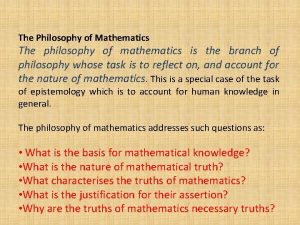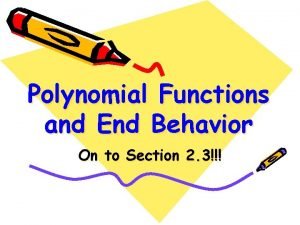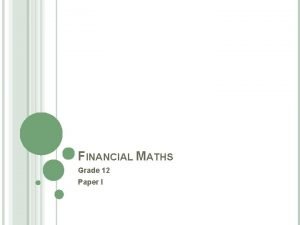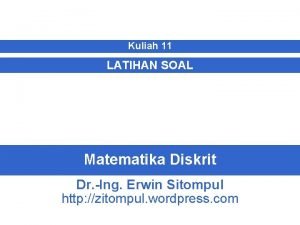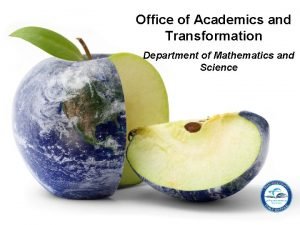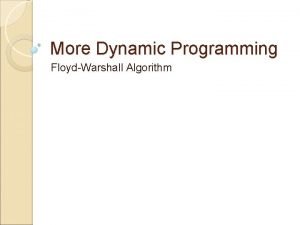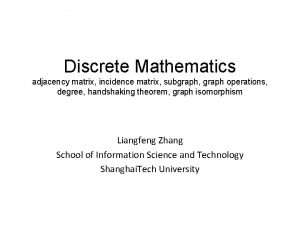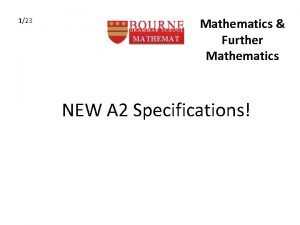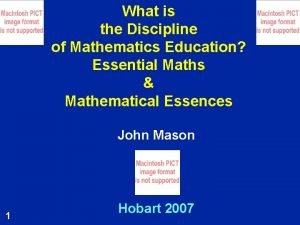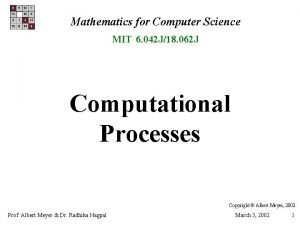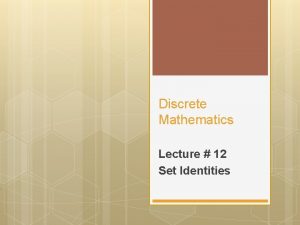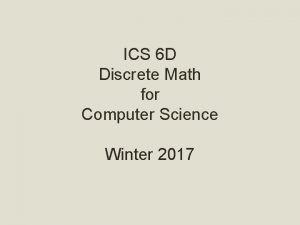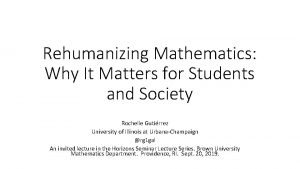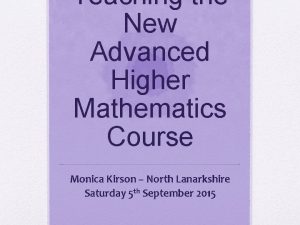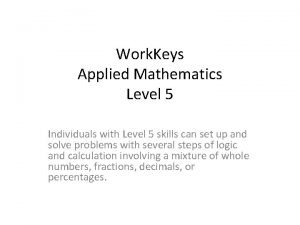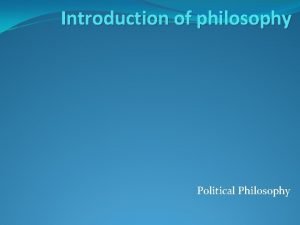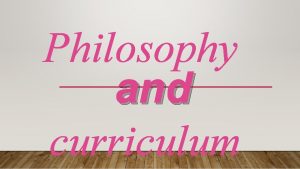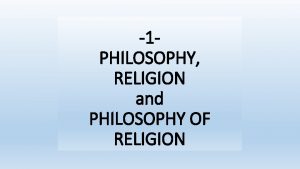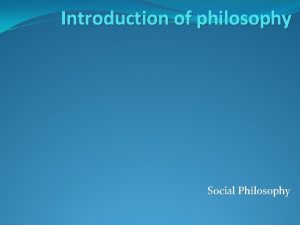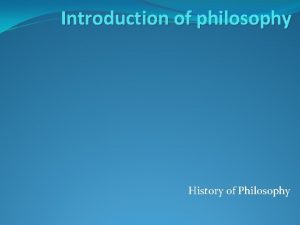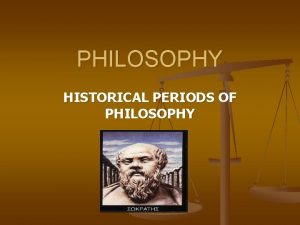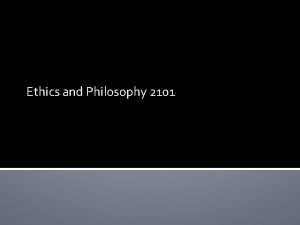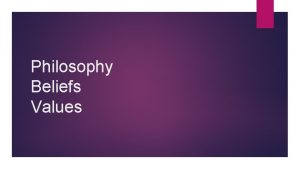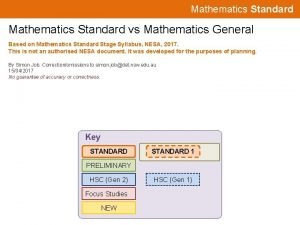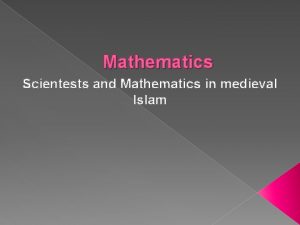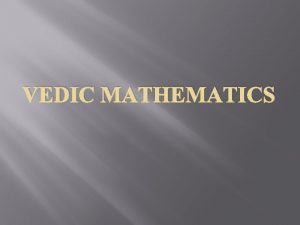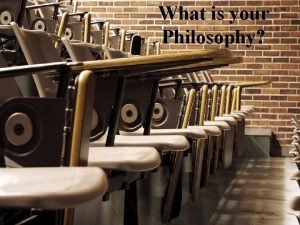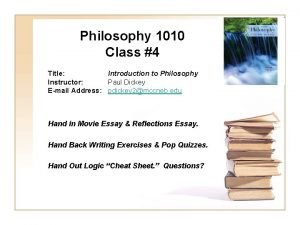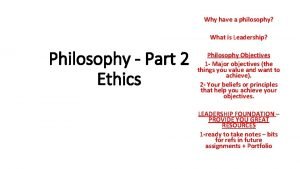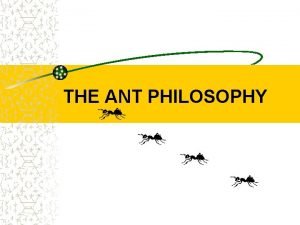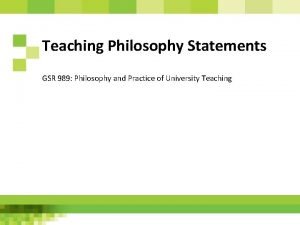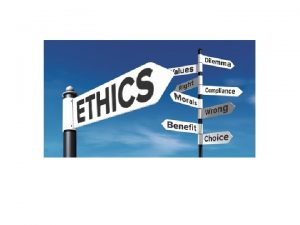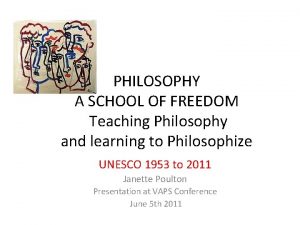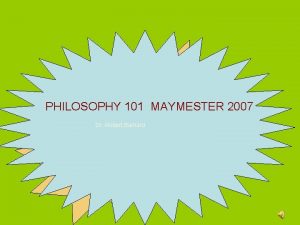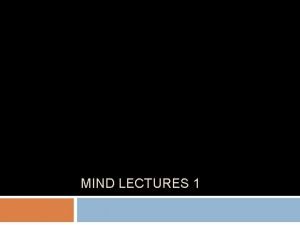The Philosophy of Mathematics The philosophy of mathematics




























































- Slides: 60

The Philosophy of Mathematics The philosophy of mathematics is the branch of philosophy whose task is to reflect on, and account for the nature of mathematics. This is a special case of the task of epistemology which is to account for human knowledge in general. The philosophy of mathematics addresses such questions as: • What is the basis for mathematical knowledge? • What is the nature of mathematical truth? • What characterises the truths of mathematics? • What is the justification for their assertion? • Why are the truths of mathematics necessary truths?

The Nature of Mathematical Knowledge Traditionally, mathematics has been viewed as the paradigm of certain knowledge. Euclid erected a magnificent logical structure nearly 2, 500 years ago in his Elements, which until the end of the nineteenth century was taken as the paradigm for establishing truth and certainty. Newton used the form of the Elements in his Principia, and Spinoza in his Ethics, to strengthen their claims to systematically expound truth. Thus mathematics has long been taken as the source of the most certain knowledge known to humankind.

Knowledge is classified on the basis of the grounds for its assertion. A priori knowledge consists of propositions which are asserted on the basis of reason alone, without recourse to observations of the world. Here reason consists of the use of deductive logic and the meanings of terms, typically to be found in definitions. In contrast, empirical or a posteriori knowledge consists of propositions asserted on the basis of experience, that is, based on the observations of the world (Woozley, 1949).

Mathematical knowledge is classified as a priori knowledge, since it consists of propositions asserted on the basis of reason alone. Reason includes deductive logic and definitions which are used, in conjunction with an assumed set of mathematical axioms or postulates, as a basis from which to infer mathematical knowledge. Thus the foundation of mathematical knowledge, that is the grounds for asserting the truth of mathematical propositions, consists of deductive proof.

The Absolutist View of Mathematical Knowledge The absolutist view of mathematical knowledge is that it consists of certain and unchallengeable truths. According to this view, mathematical knowledge is made up of absolute truths, and represents the unique realm of certain knowledge, apart from logic and statements true by virtue of the meanings of terms. Many philosophers, both modern and traditional, hold absolutist views of mathematical knowledge

The absolutist view of mathematical knowledge encountered problems at the beginning of the twentieth century when a number of antinomies and contradictions were derived in mathematics (Kline, 1980; Kneebone, 1963; Wilder, 1965). Russell produced his well-known paradox by defining the property of ‘not being an element of itself. Frege’s law allows the extension of this property to be regarded as a set. But then this set is an element of itself if, and only if, it is not; a contradiction. Frege’s Law could not be dropped without seriously weakening his system, and yet it could not be retained.

The outcome of this crisis was the development of a number of schools in the philosophy of mathematics whose aims were to account for the nature of mathematical knowledge and to re-establish its certainty. The three major schools are known as logicism, formalism and constructivism (incorporating intuitionism). The tenets of these schools of thought were not fully developed until the twentieth century, but Korner (1960) shows that their philosophical roots can be traced back at least as far as Leibniz and Kant.


Logicism is the school of thought that regards pure mathematics as a part of logic. The major proponents of this view are G. Leibniz, G. Frege (1893), B. Russell (1919), A. N. Whitehead and R. Carnap (1931). At the hands of Bertrand Russell the claims of logicism received the clearest and most explicit formulation. There are two claims: 1. All the concepts of mathematics can ultimately be reduced to logical concepts, provided that these are taken to include the concepts of set theory or some system of similar power, such as Russell’s Theory of Types. 2. All mathematical truths can be proved from the axioms and rules of inference of logic alone.

Whitehead and Russell (1910– 13) were able to establish the first of the two claims by means of chains of definitions. However logicism foundered on the second claim. Mathematics requires non-logical axioms such as the Axiom of Infinity (the set of all natural numbers is infinite) and the Axiom of Choice (the Cartesian product of a family of non-empty sets is itself nonempty).

Thus not all mathematical theorems and hence not all the truths of mathematics can be derived from the axioms of logic alone. This means that the axioms of mathematics are not eliminable in favour of those of logic. Mathematical theorems depend on an irreducible set of mathematical assumptions. Indeed, a number of important mathematical axioms are independent, and either they or their negation can be adopted, without inconsistency (Cohen, 1966). Thus the second claim of logicism is refuted

Formalism In popular terms, formalism is the view that mathematics is a meaningless formal game played with marks on paper, following rules. Traces of a formalist philosophy of mathematics can be found in the writings of Bishop Berkeley, but the major proponents of formalism are David Hilbert (1925), early J. von Neumann (1931) and H. Curry (1951).

The formalist thesis comprises two claims. 1. Pure mathematics can be expressed as uninterpreted formal systems, in which the truths of mathematics are represented by formal theorems. 2. The safety of these formal systems can be demonstrated in terms of their freedom from inconsistency, by means of meta-mathematics. Kurt Godel’s Incompleteness Theorems (Godel, 1931) showed that the programme could not be fulfilled.

Constructivism The constructivist strand in the philosophy of mathematics can be traced back at least as far as Kant and Kronecker (Korner, 1960). The constructivist programme is one of reconstructing mathematical knowledge (and reforming mathematical practice) in order to safeguard it from loss of meaning, and from contradiction. To this end, constructivists reject non-constructive arguments such as Cantor’s proof that the Real numbers are uncountable, and the logical Law of the Excluded Middle.

The best known constructivists are the intuitionists L. E. J. Brouwer (1913) and A. Heyting (1931, 1956). More recently the mathematician E. Bishop (1967) has carried the constructivist programme a long way, by reconstructing a substantial portion of Analysis, by constructive means. Various forms of constructivism still flourish today, such as in the work of the philosophical intuitionist M. Dummett (1973, 1977).

Constructivists claim that both mathematical truths and the existence of mathematical objects must be established by constructive methods. This means that mathematical constructions are needed to establish truth or existence, as opposed to methods relying on proof by contradiction. For constructivists knowledge must be established through constructive proofs, based on restricted constructivist logic, and the meaning of mathematical terms/objects consists of the formal procedures by which they are constructed.

Another problem for the constructivist view, is that some of its results are inconsistent with classical mathematics. Thus, for example, the real number continuum, as defined by the intuitionists, is countable. This contradicts the classical result not because there is an inherent contradiction, but because the definition of real numbers is different. Constructivist notions often have a different meaning from the corresponding classical notions.


The Fallacy of Absolutism We have seen that a number of absolutist philosophies of mathematics have failed to establish the logical necessity of mathematical knowledge. Each of the three schools of thought logicism, formalism and intuitionism (the most clearly enunciated form of constructivism) attempts to provide a firm foundation for mathematical truth, by deriving it by mathematical proof from a restricted but secure realm of truth.

The fact that three schools of thought in the philosophy of mathematics have failed to establish the certainty of mathematical knowledge does not settle the general issue. It is still possible for other grounds to be found for asserting the certainty of mathematical truth. Absolute truth in mathematics still remains a mathematics also have a powerful impact on the way mathematics is taught (Davis, 1967; Cooney, 1988; Ernest, 1988 b, 1989 c).

Criteria for an Adequate Philosophy of Mathematics a proposed philosophy of mathematics should account for: (i) Mathematical knowledge: its nature, justification and genesis, (ii) The objects of mathematics: their nature and origins, (iii) The applications of mathematics: its effectiveness in science, technology and other realms. (iv) Mathematical practice: the activities of mathematicians, both in the present and the past.

A Further Examination of Philosophical Schools A. The Absolutist Schools B. Progressive Absolutism C. Platonism D. Conventionalism E. Empiricism

the logicist, formalist and intuitionist schools are absolutist. We have given an account of the failure of the programmes of these schools, and indeed refuted in general the possibility of absolutism in the philosophy of mathematics.

In contrast, progressive absolutist philosophies: 1. accommodate the creation and change of axiomatic theories; 2. acknowledge that more than purely formal mathematics exists, format hematical intuition is needed as the basis for theory creation; and hence 3. acknowledge human activity and its outcomes, in the creation of new knowledge and theories.

C. Platonism is the view that the objects of mathematics have a real, objective existence in some ideal realm. It originates with Plato, and can be discerned in the writings of the logicists Frege and Russell, and includes Cantor, Bernays (1934), Hardy (1967) and Godel (1964). Platonists maintain that the objects and structures of mathematics have a real existence independent of humanity, and that doing mathematics is the process of discover ing their pre-existing relationships. According to platonism mathematical knowledge consists of descriptions of these objects and the relationships and structures connecting them.

The conventionalist view of mathematics holds that mathematical knowledge and truth are based on linguistic conventions. In particular, that the truths of logic and mathematics are analytic, true by virtue of the meanings of the terms involved. A moderate form of conventionalism, such as that of Quine (1936) or Hempel (1945), uses linguistic convention as the source of basic mathematical truth on which the edifice of mathematics is constructed. According to this view linguistic conventions provide the basic, certain truths of mathematics and logic, and deductive logic (proofs) transmits this truth to the remainder of the body of mathematical knowledge, thus establishing its certainty.

The Problem of Existence in Mathematics Among theorems of classical mathematics, one finds countless existence assertions. For example: ‘There exists areal number which is such that its cube minus seven is zero’ and ‘There exists a set whose members are just those sets that have as members only finite cardinal numbers’. Now what is the significance of asserting that some mathematical entity (or some sort of mathematical entity) exists? And what does it mean? How, in short, are we to understand existence assertions in mathematics? Philosophers might reasonably ignore such questions did they not also believe that mathematics is true, i. e. that the assertions of mathematics are for the most part true. Of course, not all people believe that mathematics is true. A Parisian mathematician once asserted, during a lecture I was giving, that in France children are not taught that the assertions of mathematics are true—instead, they are taught that these assertions are good!

The assertion ‘It was discovered that there really are black swans’ naturally gives rise to the question ‘Where are these black swans to be found? ’, but the assertion ‘It was discovered that there are continuous functions that are nowhere differentiable’ gives rise to no analogous question. It seems to make no sense, in the case of mathematics, to ask ‘Where are these functions? ’ Evidently, mathematical entities do not exist anywhere in physical space. Thus, the classical mathematician is regarded as asserting the existence of “abstract” entities not to be found in the physical world. The mathematician who believes theorems of classical mathematics to be true, according to this position, ought to believe that there really are such entities as natural numbers, functions, sets, ordered pairs, and the like. The view that emerges then is that of the mathematician investigating a realm of entities that cannot be seen, felt, heard, smelled, or tasted, even with the most sophisticated instruments.

But if this is so, how can the mathematician know that such things exist? We seem to be committing ourselves to an impossible situation in which a person has knowledge of the properties of some objects even though this person is completely cut off from any sort of causal interaction with these objects. And how does the mathematician discover the various properties and relationships of these entities that theorems seem to describe? By what powers does the mathematician arrive at mathematical knowledge? In short, how is mathematical knowledge possible? As we shall soon see, those who espouse the kind of view under consideration attempt to provide plausible answers to these queries.


these are a few of the ingredients in the mathematical image: (1) Mathematical results are certain (2) Mathematics is objective (3) Proofs are essential (4) Diagrams are psychologically useful, but prove nothing (5) Diagrams can even be misleading (6) Mathematics is wedded to classical logic (7) Mathematics is independent of sense experience (8) The history of mathematics is cumulative (9) Computer proofs are merely long and complicated regular proofs (10) Some mathematical problems are unsolvable in principle

Certainty The theorem proving the infinitude of primes seems established beyond a doubt. The natural sciences can’t give us anything like this. In spite of its wonderful accomplishments, Newtonian physics has been overturned in favour of quantum mechanics and relativity. And no one today would bet too heavily on the longevity of current theories. Mathematics, by contrast, seems the one and only place where we humans can be absolutely sure we got it right.

Let’s begin with a nice example, the proof that there are infinitely many prime numbers. If asked for a typical bit of real mathematics, your friendly neighbourhood mathematician is as likely to give this example as any. First, we need to know that some numbers, called ‘composite’, can be divided without remainder or broken into factors (e. g. 6=2× 3, 561=3× 11 × 17), while other numbers, called ‘prime’, cannot (e. g. 2, 3, 5, 7, 11, 13, 17, …). Now we can ask: How many primes are there? The answer is at least as old as Euclid and is contained in the following. Theorem: There are infinitely many prime numbers. Proof: Suppose, contrary to theorem, that there is only a finite number of primes. Thus, there will be a largest which we can call p. Now define a number n as 1 plus the product of all n=(2 x 3 x 5 x 7 x. . . xp)+1 the primes:

Is n itself prime or composite? If it is prime then our original supposition is false, since n is larger than the supposed largest prime p. So now let’s consider it composite. This means that it must be divisible (without remainder) by prime numbers. However, none of the primes up to p will divide n (since we would always have remainder 1), so any number which does divide n must be greater than p. This means that there is a prime number greater than p after all. Thus, whether n is prime or composite, our supposition that there is a largest prime number is false. Therefore, the set of prime numbers is infinite.

Objectivity Whoever first thought of this theorem and its proof made a great discovery.

Proof is essential With a proof, the result is certain; without it, belief should be suspended. That might be putting it a bit too strongly. Sometimes mathematicians believe a mathematical proposition even though they lack a proof. Perhaps we should say that without a proof a mathematical proposition is not justified and should not be used to derive other mathematical propositions. Goldbach’s conjecture is an example. It says that every even number is the sum of two primes. And there is lots of evidence for it, e. g. 4=2+2, 6=3+3, 8=3+5, 10=5+5, 12=7+5, and so on. It’s been checked into the billions without a counter-example. Biologists don’t hesitate to conclude that all ravens are black based on this sort of evidence; but mathematicians (while they might believe that Goldbach’s conjecture is true) won’t call it a theorem and won’t use it to establish other theorems—not without a proof.


Diagrams There are no illustrations or pictures in the proofs of most theorems. In some there are, but these are merely a psychological aide. The diagram helps us to understand theorem and to follow the proof—nothing more. The proof of the Pythagorean theorem or any other is the verbal/symbolic argument. Pictures can never play the role of a real proof.

Misleading diagrams Pictures, at best, are mere psychological aids; at worst they mislead us—often badly. Consider the infinite series which we can illustrate with a picture The sum of this series is 2π/6=1. 6449… In the picture, the sum is equal to the shaded area. Let’s suppose we paint the area and that this takes one can of paint.


Classical logic Notice the structure of the proof of the irrationality of. We made a supposition. We derived a contradiction from this, showing the supposition is false. Then we concluded that the negation of the supposition is true. The logical principles behind this are: first, no proposition is both true and false (noncontradiction) and second, if a proposition is false, then its negation is true (excluded middle). Classical logic, it seems, is an essential tool of mathematics. Without this tool, much of traditional mathematics would crumble.


Sense experience All measurement in the physical world works perfectly well with rational numbers. Letting the standard metre stick be our unit, we can measure any length with whatever desired accuracy our technical abilities will allow; but the accuracy will always be to some rational number (some fraction of a metre). In other words, we could not discover irrational numbers or incommensurable segments (i. e. Lengths which are not ratios of integers) by physical measurement. It is sometimes said that we learn 2+2=4 by counting apples and the like. Perhaps experience plays a role in grasping the elements of the natural numbers. But the discovery of the irrationality of was an intellectual achievement, not at all connected to sense experience.

Cumulative history The natural sciences have revolutions. But a mathematical result, once proven, lasts forever. There are mathematical revolutions in the sense of spectacular results which yield new methods to work with and which focus attention in a new field—but no theorem is ever overturned. The mathematical examples I have so far discussed all predate Ptolemaic astronomy, Newtonian mechanics, Christianity and capitalism; and no doubt they will outlive them all.

Computer proofs Computers have recently played a dramatic role in mathematics. One of the most celebrated results has to do with map colouring. How many colours are needed to insure that no adjacent countries are the same colour? Theorem: Every map is four-colourable. See: five_most_famous_problem

Some mathematical problems are unsolvable in principle Solving problems There are lots of things we might ask, but have little chance of answering: ‘Does Godexist? ’ ‘Who makes the best pizza? ’ These seem perfectly meaningful questions, but the chances of finding answers seems hopeless. By contrast, it seems that every mathematical question can be answered and every problem solved. Is every even number (greater than 2) equal to the sum of two primes? We don’t know—now, but that’s because we’ve been too stupid— so far. Yet we are not condemned to ignorance about the way we are about the home of the best pizza. It’s Goldbach’s conjecture the sort of question that we should be able to answer, and in the long run we will.

Having said this, a major qualification is in order. In fact, we may have to withdraw the claim. So far, in listing the elements of the mathematical image we’ve made no distinction among mathematicians, philosophers and the general public. But at this point we may need to distinguish. Recent results such as Gödel’s incompleteness theorem, the independence of the continuum hypothesis and others have led many mathematicians and philosophers of mathematics to believe that there are problems which are unsolvable in principle. The pessimistic principle would seem to be part of the mathematical image.

What’s the greatest discovery in the history of thought? Of course, it’s a silly question—but it won’t stop me from suggesting an answer. It’s Plato’s discovery of abstract objects. Most scientists, and indeed most philosophers, would scoff at this. Philosophers admire Plato as one of the greats, but think of his doctrine of the heavenly forms as belonging in a museum.


The Original Platonist We notice a similarity among various apples and casually say, There is something they have in common. ’ But what could this something they have in common be? Should we even take such a question literally? Plato did and said the common thing is the form of an apple. The form is a perfect apple, or perhaps a kind of blueprint. The actual apples we encounter are copies of the form; some are better copies than others. A dog is a dog in so far as it ‘participates’ in the form of a dog, and an action is morally just in so far as it participates in the form of justice.

What is Platonism? There are several points we can glean from the above remarks and from other writings of various Platonists. They form the core of Platonism. (1) Mathematical objects are perfectly real and exist independently of us Mathematical objects are nodifferent than everyday objects (pine trees) or the exotic entities of science (positrons). We don’t in any way create them; we discover them. And our theorems try to correctly describe them. Any well-formed sentence of mathematics is true or is false, and what makes it so are the objects to which the sentence refers. The truth of these propositions has nothing to do with us; it does not rest on the structure of our minds, nor on the way we use language, nor on the way we verify our conjectures.

Platonism and standard semantics (as it is often called), go hand-in-hand. Standard semantics is just what you think it is. Let us suppose the sentence ‘Mary loves ice cream’ is true. What makes it so? In answering such a question, we’d say ‘Mary’ refers to the person Mary, ‘ice cream’ to the substance, and ‘loves’ refers to a particular relation which holds between Mary and ice cream. It follows rather trivially from this that Mary exists. If she didn’t, then ‘Mary loves ice cream’ couldn’t be true, any more than ‘Phlogiston is released on burning’ could be true when phlogiston does not exist.

The same semantical considerations imply Platonism. Consider the following true sentences: ‘ 7+5=12’ and ‘ 7>3’. Both of these require the number 7 to exist, otherwise the sentences would be false. In standard semantics the objects denoted by singular terms in true sentences (‘Mary’, ‘ 7’) exist. Consequently, mathematical objects do exist.

(2) Mathematical objects are outside of space and time The typical subject matter of natural science consists of physical objects in space and time. For pine trees, positrons and pussy-cats, we can always say where and when; not so for primes, , or polynomials. The standard metre is kept in a special place in Paris; not so the number 27 which is to be found nowhere in space and time, though it is just as real as the Rock of Gibraltar. Some commentators like to say that numbers ‘exist’, but they don’t ‘subsist’. If this just means that they are not physical, but still perfectly real, fine. If it means something else, then it’s probably just confused nonsense.

(3) Mathematical entities are abstract in one sense, but not in another The term ‘abstract’ has come to have two distinct meanings. The older sense pertains to universals and particulars. A universal, say redness, is abstracted from particular red apples, red blood, red socks, and so on; it is the one associated with the many. The notions of group, or vector space perhaps fit this pattern. Numbers, by contrast, are not abstract in this sense, since each of the integers is a unique individual, a particular, not a universal.

On the other hand, in more current usage ‘abstract’ simply means outside space and time, not concrete, not physical. In this sense all mathematical objects are abstract. A simple argument makes this clear: There are infinitely many numbers, but only a finite number of physical entities; so most mathematical entities must be non-physical. It would seem rather unlikely that, say, the first n numbers are physical while from n +1 on they are abstract. So, the reasonable conclusion is that all numbers, and indeed all mathematical objects, are abstract.

(4) We can intuit mathematical objects and grasp mathematical truths Mathematical entities can be ‘seen’ or ‘grasped’ with ‘the mind’s eye’. These terms are, of course, metaphors, but I’m not sure we can do better. The main idea is that we have a kind of access to the mathematical realm that is something like our perceptual access to the physical realm. This doesn’t mean that we have direct access to everything; the mathematical realm may be like the physical where we see some things, such as white streaks in bubble chambers, but we don’t see others, such as positrons.

(6) Even though mathematics is a priori, it need not be certain These are quite distinct concepts. The mind’s eye is subject to illusions and the vicissitudes of concept formation just as the empirical senses are. And axioms are often conjectures, not selfevident truths, proposed to capture what is intuitively grasped. Conjecturing in mathematics is just as fallible as it is elsewhere.

(7) Platonism, more than any other account of mathematics, is open to the possibility of an endless variety of investigative techniques Proving theorems in a traditional way is certainly one method of establishing new mathematical truths, but it needn’t be the only way, and Platonism does not stress it. In the natural sciences one might start from, say, the first principles of quantum mechanics and derive a new result. In this fashion we would come to know something new. But, of course, there are numerous other ways of learning new things about the physical world, including: direct observation, hypothesizing and testing the observable consequences, analogical reasoning, thought experimenting, and so on. Platonism can be similarly liberating for mathematical research.

 Absolutist view of mathematics
Absolutist view of mathematics Platonism definition
Platonism definition Cái miệng bé xinh thế chỉ nói điều hay thôi
Cái miệng bé xinh thế chỉ nói điều hay thôi Hát kết hợp bộ gõ cơ thể
Hát kết hợp bộ gõ cơ thể Từ ngữ thể hiện lòng nhân hậu
Từ ngữ thể hiện lòng nhân hậu Trời xanh đây là của chúng ta thể thơ
Trời xanh đây là của chúng ta thể thơ Tư thế ngồi viết
Tư thế ngồi viết Giọng cùng tên là
Giọng cùng tên là Chó sói
Chó sói Thơ thất ngôn tứ tuyệt đường luật
Thơ thất ngôn tứ tuyệt đường luật Hổ đẻ mỗi lứa mấy con
Hổ đẻ mỗi lứa mấy con Thế nào là hệ số cao nhất
Thế nào là hệ số cao nhất Diễn thế sinh thái là
Diễn thế sinh thái là đại từ thay thế
đại từ thay thế Lp html
Lp html Vẽ hình chiếu vuông góc của vật thể sau
Vẽ hình chiếu vuông góc của vật thể sau Làm thế nào để 102-1=99
Làm thế nào để 102-1=99 Thế nào là mạng điện lắp đặt kiểu nổi
Thế nào là mạng điện lắp đặt kiểu nổi Mật thư tọa độ 5x5
Mật thư tọa độ 5x5 Lời thề hippocrates
Lời thề hippocrates Vẽ hình chiếu đứng bằng cạnh của vật thể
Vẽ hình chiếu đứng bằng cạnh của vật thể Tư thế worms-breton
Tư thế worms-breton Quá trình desamine hóa có thể tạo ra
Quá trình desamine hóa có thể tạo ra Khi nào hổ mẹ dạy hổ con săn mồi
Khi nào hổ mẹ dạy hổ con săn mồi Các châu lục và đại dương trên thế giới
Các châu lục và đại dương trên thế giới Các loại đột biến cấu trúc nhiễm sắc thể
Các loại đột biến cấu trúc nhiễm sắc thể Bổ thể
Bổ thể Nguyên nhân của sự mỏi cơ sinh 8
Nguyên nhân của sự mỏi cơ sinh 8 độ dài liên kết
độ dài liên kết Thiếu nhi thế giới liên hoan
Thiếu nhi thế giới liên hoan Fecboak
Fecboak Hát lên người ơi alleluia
Hát lên người ơi alleluia điện thế nghỉ
điện thế nghỉ Một số thể thơ truyền thống
Một số thể thơ truyền thống Hệ hô hấp
Hệ hô hấp Công của trọng lực
Công của trọng lực Các số nguyên tố
Các số nguyên tố đặc điểm cơ thể của người tối cổ
đặc điểm cơ thể của người tối cổ Tỉ lệ cơ thể trẻ em
Tỉ lệ cơ thể trẻ em Các châu lục và đại dương trên thế giới
Các châu lục và đại dương trên thế giới ưu thế lai là gì
ưu thế lai là gì Tư thế ngồi viết
Tư thế ngồi viết Thẻ vin
Thẻ vin Môn thể thao bắt đầu bằng từ chạy
Môn thể thao bắt đầu bằng từ chạy End behavior definition
End behavior definition Finance maths grade 12
Finance maths grade 12 Discrete math problem
Discrete math problem Office of academics and transformation
Office of academics and transformation Transitive closure in discrete mathematics
Transitive closure in discrete mathematics Neatness rubrics
Neatness rubrics Incidence matrix in discrete mathematics
Incidence matrix in discrete mathematics Ics subjects
Ics subjects Discipline in mathematics
Discipline in mathematics Using mathematics and computational thinking
Using mathematics and computational thinking A computer programming team has 13 members
A computer programming team has 13 members Mathematics for computer science mit
Mathematics for computer science mit Identity law in sets
Identity law in sets Sslh uci
Sslh uci Rehumanizing mathematics
Rehumanizing mathematics Ahmaths
Ahmaths As a laboratory assistant you measure chemicals
As a laboratory assistant you measure chemicals
